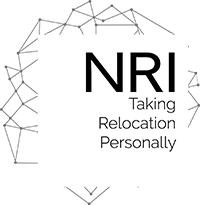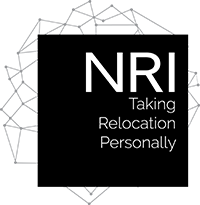NRI Relocation’s Best Practices For Company Relocation Policy & Procedures
How does your company relocation program stand up against your competition? Whether you are creating your business’s first employee relocation policies or seeking to implement corporate relocation policy best practices, these critical considerations can make or break the success of your company’s corporate relocation program.
Organizations of every size should establish a company relocation policy, even if your company performs only a few employee relocations annually. Corporate relocation policies impact far more than just employee benefits. Relocation also influences company culture, budgets, recruiting, retention, and compliance.
NRI’s relocation consultants have crafted hundreds of corporate relocation policies. We have seen companies’ mistakes when designing and implementing relocation policies, and we understand the components of a successful relocation program.
These are the relocation policy best practices that NRI’s relocation experts include in every client’s mobility strategy. These examples are the starting points for our relocation policy design.
Corporate Relocation Policy Best Practices
There are hundreds of questions and details that a company must consider while creating relocation policies and procedures. These are the top relocation policy best practices that NRI Relocation’s consultants utilize while designing domestic or global mobility strategies.
1. Determine both the cultural and financial end goals for the company relocation policy.
Every company’s relocation policy is a balance between cultural and financial goals.
Remember, relocation benefits are often a prospective employee’s first impression of a company. That’s why a full-service relocation policy can attract a candidate or make an employee feel valued and cared for. As a result, a successful relocation program positively contributes to the workplace environment and improves recruitment and retention.
In addition, relocation policies directly impact productivity and an employee’s ability to get up to speed at a new company or role. When employers provide comprehensive relocation support, employees can quickly arrive at their new worksite and focus on their job instead of the stress of managing a relocation.
However, extensive relocation services may inflate benefits budgets. A good relocation policy manages this balance by identifying the most important relocation services and determining the correct level and spending for each benefit. These guidelines ensure businesses meet each employee’s unique needs while mitigating the waste of a blanket policy or relocation allowance.
2. Choose what the relocation allowance policy will cover.
The included services are the core of a company’s relocation policy. Most employee relocation packages include moving household goods, travel, and assistance with housing transactions.
However, what will the service level be for these key relocation services? For example, will the company expand the household goods moving allowance to include packing, vehicle transport, storage, pet relocation, and other third-party services for senior employees?
In addition, relocation requires services beyond moving and real estate. Your organization will need to choose how to handle needs such as temporary housing, support for the family, and home-finding trips.
International relocations require even more services, such as immigration, language training, and cultural education.
Organizations must decide whether to include additional services into their corporate relocation policy, add a miscellaneous relocation allowance to cover other related expenses or require the employee to handle those needs themselves.
3. Include all the relevant relocation services.
To meet employee expectations and compete for talent, a relocation package should include all the standard services. Here are corporate relocation policy examples of included services:

What should a US domestic relocation policy include?
- Home finding trips
- Temporary living
- Renter services
- Home sale assistance
- Home purchase assistance
- Household goods move
- Expense management
- Miscellaneous allowance
- Payback agreements
What should a global mobility relocation policy include?
Global relocations should include all of the benefits of a domestic relocation policy, as well as:
- Visa/immigration support
- Tax consultation support
- Air and sea household goods shipments
- Destination services for the family, including school search and settling in
- Language and cultural training
- Car services such as a driver, rental car, car purchase, or lease
What should a C-level relocation policy include?
High-value talent requires additional benefits, including:
- White glove services
- Extended periods for the standard relocation benefits
- A higher level of household goods services, including full unpacking and organization
- Perks, such as airport pickups, welcome baskets, grocery deliveries, and chef services
4. Take relocation allowance tax implications into account.
Tax implications can make or break employees’ satisfaction with their company’s relocation policy and, therefore, their experience with the organization.
Relocation allowances and reimbursements are taxable, which can be a significant financial burden for employees. However, companies can design relocation policies to protect both employees and companies from additional tax expenses.
For example, managed corporate relocation services through an outsourced relocation company avoid additional taxes on an employee’s relocation benefits.
Employers can also use qualified home sale programs, such as buyer value options or guaranteed buyout options, to write off an employee’s real estate transaction expenses.
5. Take the entire employee’s family’s needs and lifestyle into consideration
A common mistake is creating only one relocation policy and expecting it to work for all relocating employees. Every employee’s relocation needs are unique and specific to their lifestyle.
For example, an employee’s housing needs will greatly vary depending on whether they are a homeowner or renter. A homeowner requires significant real estate fees to achieve their relocation. On the other hand, a renter may need to depart before the end of their lease. The home-finding process and requirements will also vary by an employee’s housing status.
An employee’s family is another substantial impact on relocation policies and costs. Employees with partners and children usually have more needs in a transition than a single transferee. A policy must determine which family members’ needs are included in the program. For example, does a domestic partner or other family members in the household receive the benefits?
Remember, care for an employee’s family significantly influences the success of a relocation. The transition and happiness of an employee’s partner or children can make or break an employee’s decision to stay with a company or take an assignment.
Therefore, companies must ensure that their corporate relocation policy tiers account for more than just the employee’s seniority and company role.

6. Create employee relocation policy tiers by seniority.
When it comes to employee relocation policies, one size does not fit all.
What’s required to attract and provide for talent varies at different career stages. Organizations can entice and retain high-value candidates while balancing budgets by implementing different corporate relocation policy tiers based on employee seniority.
C-suite, executive, and leadership employees bring a wealth of expertise and value to organizations. These A-players are also in high demand. Companies must offer greater compensation, including more extensive benefits, to bring in experienced talent.
Higher-level employees also have more demanding and time-consuming responsibilities. Any distraction from an executive’s work can be costly to a company. By providing more relocation benefits, companies can ensure smooth transitions for their leaders, enabling senior employees to hit the ground running in their new roles.
Entry or mid-level employees deserve quality relocation care too. That’s why a relocation policy must include a clear protocol for the specific relocation benefits for each position and scenario.
By adjusting the relocation package tiers to your organization’s roles, your company can cater to the different needs of each seniority level, align benefits and compensation, and optimize the relocation budget.
7. Implement a domestic relocation policy and a global mobility relocation policy.
Global mobility services are more extensive and complex than domestic corporate relocation services. Employees who go abroad for an assignment require immigration, cultural & language training, increased family assistance, tax and compensation guidance, and more.
All companies should perform a global mobility needs assessment, even if you don’t think your organization performs enough international relocations to implement a full international relocation policy. The world economy moves quickly, and the necessity to send an employee abroad is usually unexpected. Having the cost information on hand allows businesses to make agile international business decisions.
If your organization is currently writing a global relocation policy, tailor the services to the length of the assignment. Like a domestic relocation policy, include seniority tiers, and always consider the employee’s family.
8. Understand how employee relocation costs vary.
Setting standard relocation allowances doesn’t account for employee moves’ extreme cost variations. Companies must have an intricate understanding of relocation’s variables. The following factors have significant relocation expense implications:
- Cost of living at the origin and destination
- Distance between the origin and destination
- Whether the employee rents or owns their home
- The employee’s home size
- The employee’s family size
- The employee’s pay scale or seniority
NRI’s relocation consultants recommend calculating budgets for several relocation policy example scenarios. This exercise allows organizations to forecast relocation budgets more accurately.
9. Build timelines for all relocation policy samples.
Timelines and deadlines are also vital components of a relocation policy. How quickly an employee must begin in their next location considerably impacts costs.
Policies should also outline the time length of the benefit, relocation timeline expectations, and deadlines for employees to utilize their relocation package services.
Internal deadlines are equally important. Clarify when employees must submit expenses for reimbursement. Communicating when employees can expect refunds or equity advance bonuses promotes satisfaction with the process.
10. Involve all departments and management in the company relocation policy best practices.
A company’s relocation policy is a roadmap. As we say at NRI, the transferee, human resources, leadership, and the relocation management company should all be singing from the same songbook.
All stakeholders should be involved in the relocation program from the beginning.
- Leadership sets the culture of employee care and buys into the budget
- Human resources set the process to manage and implement the relocations
- Recruiting needs to match the benefits to their talent goals
- Managers need to understand how the program impacts employees
- Some organizations even involve employees to gauge which relocation benefits most closely align with their company culture
- The relocation management company guides the process and provides their expertise
No matter who’s involved, do not get too far down the road of planning a relocation policy without receiving feedback from all parties. There are so many questions to answer in the relocation policy process. Companies need the right people in the room to answer them.

11. Include extreme detail in relocation policy and procedures.
Paula Keats-Ward, NRI Relocation’s Vice President of Customer Success, loves to say that “the devil is in the details.” Many companies’ relocation policies are too general. Including details and accounting for a wide range of scenarios reduces confusion and conflict between an employee and employer.
Companies achieve successful employee relocations by meeting their expectations. If a thorough relocation policy does not properly set expectations, then the employee’s satisfaction with the move will fall short.
Some relocation policy examples of overlooked relocation components include:
- What is the maximum length of a temporary living benefit?
- In which scenarios are meals included in the relocation?
- Does the company pay for return trips to an employee’s origin?
- Is special handling for fragile or bulky belongings included in the moving package?
- Does the policy account for a diversity of employee family scenarios?
For example, even the most common relocation benefit, household goods moving, can be incredibly complicated. In fact, a typical NRI Relocation-crafted policy includes two to five pages to cover which services are included and excluded in a household goods relocation benefit!
That’s why working with a corporate relocation company to create a policy can be beneficial. A relocation provider can bring their extensive experience into the strategy. That way, your relocation policy accounts for the hundreds of scenarios we’ve experienced as relocation professionals.
12. Ensure the corporate relocation policy is compliant.
A robust corporate relocation policy is essential for businesses to navigate the complex landscape of payroll reporting and taxable expenses. One of the policy’s roles is ensuring compliance with legal requirements.
For example, tax laws and reporting obligations can differ when employees move across state or national borders. Businesses can stay on top of these complexities when a policy includes clear relocation reporting requirements.
Companies can avoid penalties and legal issues by maintaining accurate relocation records and promptly reporting information to the relevant authorities.
13. Your company needs more than a relocation reimbursement policy.
As evident in this article, a relocation reimbursement policy just doesn’t cut it in the complex world of relocation costs and processes. Instead, a detailed relocation policy with multiple tiers and scenarios mitigates wasteful spending. Even if your organization only requires a few relocations a year, the diligence of writing a comprehensive relocation policy substantially increases the success of your investment in your employees.
Start Planning Your Employee Relocation Policy
Writing a relocation policy is an involved process that takes time. Organizations must prepare a policy before they need one. Otherwise, they risk delaying a critical employee transfer or losing a valuable hire.
If you’re ready to start planning a relocation program that takes all the relocation policy best practices into account, NRI Relocation’s experts are standing by for your consultation. Contact us to begin or improve your corporate relocation program.


